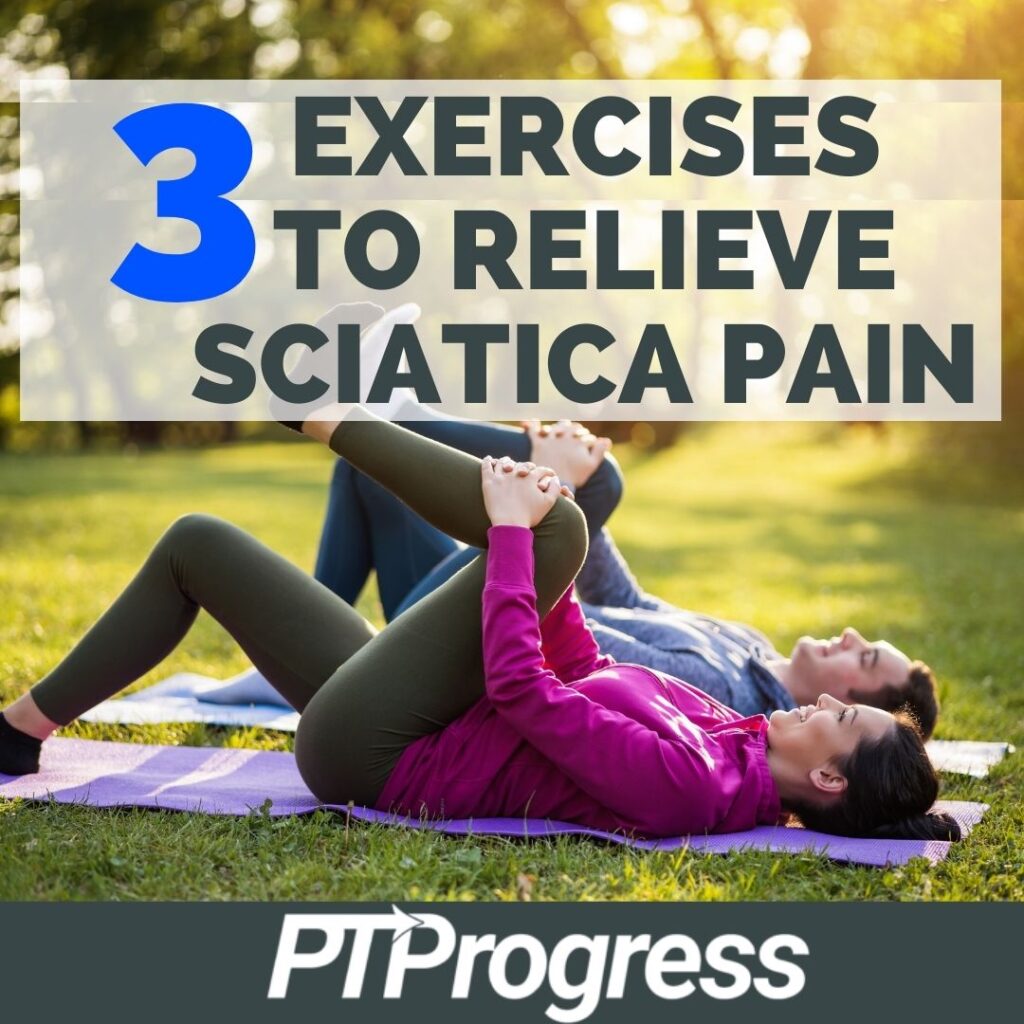If you have low back pain with symptoms of sciatica, you know the frustration that comes with it. From leg weakness to numbness and tingling in your feet, sciatica is a potentially debilitating condition that can leave you feeling helpless.
But don’t lose hope! As a Physical Therapist, I’ve treated many patients suffering from sciatica, and I’ve discovered some helpful exercises for reducing sciatica symptoms and building overall strength.
3 Easy Exercises for Sciatica Relief
1. Spinal Decompression Techniques for Sciatica
Spinal compression is often a major contributor to sciatica. Vertebral discs break down over time, and as a result, the space between each vertebra narrows, compressing the nerve roots at the spine. This compression can cause weakness or give the sensation of numbness and tingling down your leg.
Decompression techniques are a great way to provide immediate relief and promote healing in the affected area.
Seated Decompression
This first technique involves simply sitting in a chair and pressing up with your arms. The goal is to provide just enough of a lift with your arms to take the pressure off your spine. As you press up, your bottom may lift slightly from the chair, which is a good thing. Just make sure you’re relaxed so that the muscles around your spine aren’t working against your efforts for decompression.
Repeat this press-up motion 20 times, holding for 5 to 10 seconds each time.
Supine Decompression
Another effective way to decompress the spine is to provide manual traction. To start, lie on your back and elevate your legs onto a surface, such as the seat cushions of your couch. With your legs in an “L” position, place your hands on your thighs and press into them as if you’re trying to make yourself taller. This decompression technique should provide relief, so stop if it feels painful.
Press and hold for 5 to 10 seconds; repeat 20 times.
2. Sciatic Nerve Glides
Decompression isn’t the only technique for relieving sciatic pain; nerve glides are also effective.
Despite how it looks, the goal of a nerve glide isn’t to “stretch” the nerve. Imagine each nerve as a piece of floss; it’s hard to stretch floss, and the same is true for nerves. Rather, the goal of this technique is to “floss” the nerve back and forth using simple movements and controlled motion through as wide a range as possible.
Seated Nerve Glide
Begin by sitting at the edge of a bed or in an elevated stool. Lean forward as if you are slouching in your chair, allowing your head to flex down towards your chest. Now extend one leg out straight. You may feel a tightness or pulling in the back of your leg or even experience some familiar sciatica symptoms of numbness and tingling. Repeat this motion, extending and bending your leg, and you’ll notice that it becomes easier after a few repetitions. You can advance this movement by flexing your foot towards your head as your leg fully extends. This subtle flexion of the foot places the nerve under greatest tension.
Repeat this movement 10 times, moving slowly through each repetition.
Supine Sciatic Nerve Glides
This same technique can be performed in supine, or lying on your back. While on your back, bring one knee towards your chest and place your hands behind your thigh for support. Next, straighten your leg and extend your knee towards the ceiling in a controlled motion so that you feel a tightness or pulling behind your leg. Carefully flex your foot towards your head, as you did in the previous exercise, and you’ll feel an even greater pull along the back of the leg.
Repeat this “flossing” motion 10 times, moving slowly through each repetition.
3. Walking Exercises for Sciatica
When experiencing sciatica, you may feel a pulling sensation in your leg and limp as you walk. Unfortunately, a limp can lead to a variety of compensations in your gait pattern and even result in additional back or knee pain.
As a way to “relearn” how to walk with sciatic pain, try these simple exercises.
Standing glute squeezes
Before you take a step, squeeze your butt muscles (your glutes). This safeguards your body from making a harmful compensation to your gait.
The sciatic nerve runs down your leg directly past the glutes. If this nerve is irritated, you may subconsciously avoid using muscles that pull or shift this sciatic nerve. Unfortunately, if you stop engaging your glutes as you should, you will compromise your gait pattern. Simply squeezing your glutes will help your body “relearn” how to use the right muscles while walking.
Think “Heel-toe” with Each Step
Ideally when you walk, each footfall should begin with a heel strike, roll through the foot, and push off from the toes. If you have sciatica, this fluid motion becomes more of a peg-leg motion, because you can’t land on your heel when you’re trying to avoid flexing your foot. After all, flexing the foot puts the nerve under greatest tension, as we learned with the sciatic nerve glides. But if you want to start walking “normally” again, this is a key exercise to practice.
First off, you may need to walk slower and take shorter steps. It will do you no good to reinforce bad patterns, so slow your pace and shorten your steps.
Secondly, with every step, try to make your foot rock from heel to toe. The goal isn’t to walk with one foot in front of the other in a heel-to-toe stepping pattern. Instead, keep your feet a normal width apart and simply imagine that each foot has a tube of toothpaste attached to the bottom of it. Try to squeeze out the toothpaste completely with every heel-toe step.
Exercises for Sciatica: Follow up!
While these are great starter exercises for managing symptoms of sciatica, you may need even more focused treatment. Be sure to follow up with your physical therapist to figure out what exercises work best for you.


